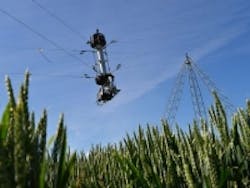Plant scientists develop airborne vision system for crop phenotyping
Scientists from the ETH Institute of Agricultural Sciences’ Research Station in Lindau-Eschikon have developed a vision system suspended above small plots of different varieties of crops that is used to measure and monitor the health and performance of field crops.
The system was inspired by the aerial "spider cams" suspended above soccer stadiums, which were used in the broadcasts of the Euro 2016 matches, and provide a "birds eye" view of the pitch for television viewers. The phenotyping system transfers research capabilities from the lab to the field, according to ETH Zurich, and will allow scientists to study crops in high detail throughout the entire year.
Developed to discover the differences between the individual plant varieties, to determine how long they need to flower, and to discover the link between their growth and the ambient temperature and soil moisture, the system currently studies hundreds of plots of different varieties of wheat, soy, maize, buckwheat, and forage grasses. Additionally, the system allows the team to investigate whether, or how, fungal diseases develop on the crops, and to monitor weed cover on the ground.
"In the long run, our system is a valuable tool for crop cultivation and precision farming," said Achim Walter, Professor of Crop Science at ETH Zurich.
In the setup, four masts, each one 24 meters high, are positioned at four corners of a plot measure 100 x 130 meters. Between the masts, double-braided aramid cables carry the moving sensor head, which hovers up to seven meters above the ground and features multispectral cameras, an infrared camera, two spectrometers, and a laser measuring device. Electric cable-winches at the foot of the masts adjust the lengths of cable between the sensor head and masts, allowing the sensor to be accurately positioned anywhere above the plot, without touching the ground or disturbing the crops.
Professor Walter hopes to be able to gather valuable trial data and to discover more about the limitations and potential applications of different sensors suitable for use in farming in the future, including on tractors, drones, or smartphones.
"In ten years’ time the experienced eye of the farmer and grower will be supported by a broad range of digital tools capable of identifying diseases and providing information on the potential use of crop agents, for example," he said. "This system enables us to find out sooner and more accurately exactly what challenges we need to tackle in future. What type of advice do we want? Which tasks can we delegate to algorithms and machines, and how much can we depend on them?"
View the project page.
Share your vision-related news by contacting James Carroll, Senior Web Editor, Vision Systems Design
To receive news like this in your inbox, click here.
Join our LinkedIn group | Like us on Facebook | Follow us on Twitter
About the Author

James Carroll
Former VSD Editor James Carroll joined the team 2013. Carroll covered machine vision and imaging from numerous angles, including application stories, industry news, market updates, and new products. In addition to writing and editing articles, Carroll managed the Innovators Awards program and webcasts.
